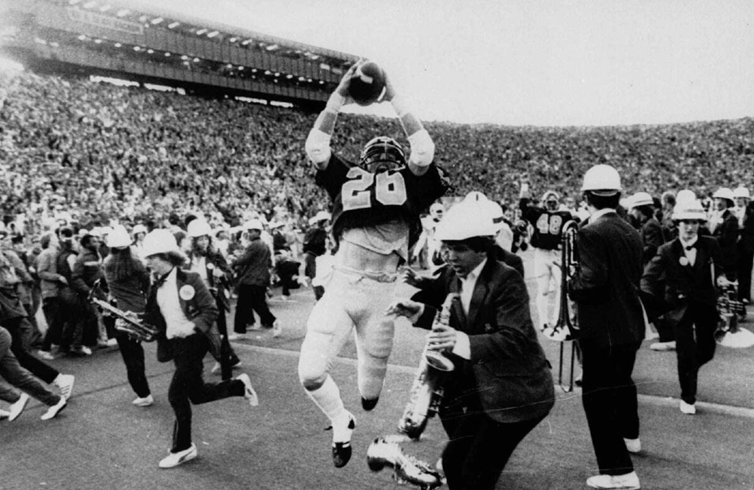
To listen to today’s reflection as a podcast, click here
It’s simply called The Play.
Radio announcer Joe Starkey, trying to describe what he had just seen, called it “the most amazing, sensational, dramatic, heart-rending, exciting, thrilling finish in the history of college football!”
He just might be right. Even though the last-second, game-winning, five-lateral, walk-off kickoff return happened 43 years ago this fall, it’s still a hot topic. And its outcome is still far from settled in the minds of those who ended up holding the short end of the stick.
The Play, appropriately, came at the end of The Big Game, one of college football’s most storied rivalries. The Stanford Cardinal and California Golden Bears have been slugging it out at the end of every season since 1892. They play for the right to possess, for the following 12 months, a trophy called the Stanford Axe, which preserves the score of every preceding Big Game.
A lot more was a stake, however, on Saturday, November 20, 1982.
Stanford’s celebrated quarterback, John Elway, had never taken his team to a postseason bowl game. If he could lead the 5-5 Cardinal to victory, it would make them bowl-eligible. And he would quite possibly win the Heisman Trophy.
As the clock wound down in the fourth quarter, everything seemed aligned for a Stanford triumph on Cal’s home field. Elway drove his troops deep into Golden Bear territory, where a field goal attempt split the uprights and gave Stanford a 20-19 lead.
Only four seconds remained. All Stanford had to do was squib the kickoff (so it would be hard to return), tackle whomever picked up the ball for Cal, and let the celebration begin. Piece of cake.
But in the words of the recently-retired Lee Corso, “Not so fast, my friend.”
Kevin Moen of Cal collected the kickoff at his own 45. As Cardinal tacklers approached, he pitched it backwards to a teammate, who quickly lateraled to a third player. Five Stanford players closed in for the kill. But the ball somehow came flying out of that pile, back into the hands of the second Cal player. Had his knee touched the ground first?
There was no signal from the refs. The ball was still alive.
Stanford players on the sideline, convinced the game was over, had already walked onto the field. The Stanford band, all 144 members, had left their staging area in the end zone and begun to march up the field toward the action. Some reached the 20 yard line.
After a fourth lateral, Kevin Moen was in the right place at the right time to receive the fifth one. But had the ball been thrown forwards instead of backwards?
He just kept running, dodging Stanford tacklers and band members alike, crossing the goal line and crashing into Gary Tyrrell, a trombone player. Touchdown! But was it legit?
Confusion reigned. The Stanford coaches were protesting. There were flags everywhere because so many non-players had taken the field. The officials huddled. “There were some pale faces,” remembers Referee Charles Moffett. But not a single official could authoritatively say that Cal had done anything wrong.
Moffett stepped out to address the crowd. The stadium grew quiet. “(W}hen I raised my arms [signaling a touchdown], I thought I had started World War III. It was like an atomic bomb had gone off.”
Here’s the video, which has been scrutinized over the past four decades almost as much as the Zapruder film of the JFK assassination: The Play from the Cal vs. Stanford 1982 Big Game #GoBears. Aside from the unbridled joy of Joe Starkey’s commentary, what can we know for sure?
We can know that the TV replays that afternoon were inconclusive. The score stood. Cal had beaten their archenemy, 25-20.
Stanford, to put it mildly, has had a hard time believing they actually lost.
The football program went into a kind of shock. Recruiting suffered. The following year, the coach was fired after posting a miserable 1-10 record. He blamed the band.
Elway, who went on to NFL stardom and the Pro Football Hall of Fame, expressed bitterness for years. He believed his bowl game and his chance at the Heisman had been stolen by the refs.
In recent years, whenever Stanford has won The Big Game and taken home the Axe, they change the score of the 1982 match to the “correct” one – only to have Cal change it back the next time the Axe is theirs.
What’s the antidote for such a serious case of lingering disappointment? A sense of humor helps. Gary Tyrrell’s smashed trombone is currently on display in the College Football Hall of Fame. “I thought I’d be famous for my talent as a musician, not for being knocked down at a football game,” he reflects.
Even Elway has mellowed. “Each year,” he admits, “it gets a little funnier.”
Author and theologian Lewis Smedes noted that at some point we all have to make peace with the fact that we cannot have a different yesterday. At some point we all have to stop trying to “change the score.”
But we can definitely have a different today.
We can love. And we can listen. We can tell the truth and keep our promises. We can forgive.
And we can thank God that we are heading towards an incredible tomorrow. There’s a new world coming, and if you’ve thrown in your lot with Jesus, it will be beyond your wildest imagination.
To put it in football terms, your game is far from over. The clock is still ticking. Choose to make this a day in which you keep moving forward.
You also might want to keep your eyes open.
There might be a band on the field.
